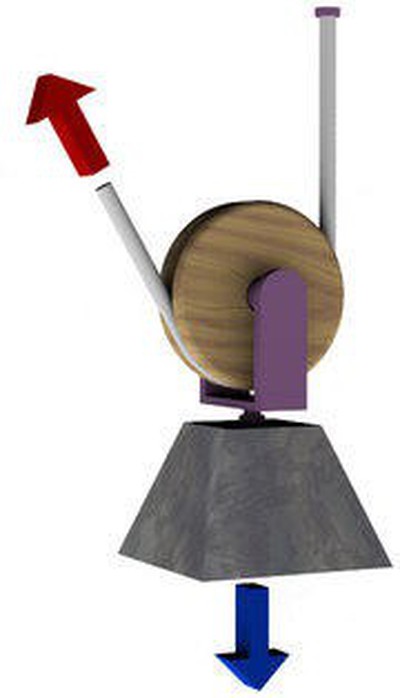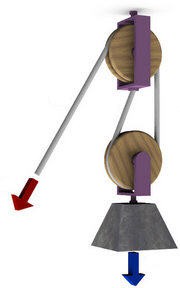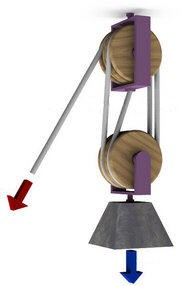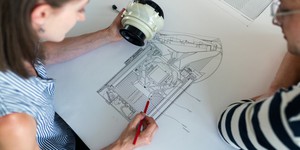Abstract
Before the Industrial Age, people relied on muscle power for moving and lifting heavy objects. Here's a project that shows you how you can use your head to make heavy lifting easier on your muscles–and your back!Summary
Andrew Olson, Ph.D., Science Buddies

Objective
The goal of this project is to measure the force and the work required to lift the same load with different arrangements of pulleys.
Introduction
Pulleys are machines that make the job of lifting objects easier. A simple pulley (see Figure 1) consists of a single wheel, mounted on an axle and held in a small frame.
 Image Credit
Image Credit
The edge of the wheel has a channel, through which a rope can pass. The pulley can be used to lift an object, as shown in Figure 1. Here one end of the rope is fixed in place (top right) and the object to be lifted is attached to the pulley. Pulling on the other end of the rope lifts the object.In another arrangement (not shown), the pulley is fixed in place (e.g., to an overhead beam) and the rope passes over the pulley. One end of the rope is attached to the object. By pulling down on the other end of the rope, the object is lifted.
Two (or more) pulleys can be arranged to work together as shown in Figure 2. This is an example of a compound pulley arrangment.
 Image Credit
Image Credit
One end of the rope is fixed to the upper pulley, as shown above. The rope passes around the lower pulley, and then around the upper pulley. The object to be lifted is attached to the lower pulley. By pulling down on the rope, the object is lifted.
A block and tackle is an arrangement that uses multiple pulleys mounted on the same axle. The pulleys are the "blocks" and the rope is the "tackle." An example is shown in Figure 3.
 Image Credit
Image Credit
In Figure 3, both the upper and the lower block have two pulleys on the same axle. The object to be lifted is attached to the lower block. One end of the rope is fixed to the upper block, and then passes around the first pulley in the lower block. Next, the rope passes over the first pulley in the upper block, then down to the second pulley in the lower block. Finally, the rope passes over the second pulley in the upper block. As with the compound pulley shown in Figure 2, pulling down on the rope raises the object.
What is the point of connecting multiple pulleys into a compound pulley or block and tackle arrangement? How about building them for yourself to find out?
Terms and Concepts
To do this project, you should do research that enables you to understand the following terms and concepts:
- simple pulley,
- compound pulley,
- block and tackle,
- force,
- work,
- mechanical advantage,
- energy conservation.
Questions
- How does physics define the term, work?
- What are the SI units for force?
- What are the SI units for work?
Bibliography
- Editor, 2005. Index to Units and Systems of Units, Sizes.com. Retrieved April 19, 2006.
- Wikipedia contributors, 2006. Pulley, Wikipedia, The Free Encyclopedia. Retrieved April 19, 2006.
- EDinformatics, date unknown. Simple Machines: The Pulley, EDinformatics.com. Retrieved April 19, 2006.
- Henderson, T., 2004. Work, Energy and Power, The Physics Classroom. Retrieved April 19, 2006.
Materials and Equipment
To do this experiment you will need the following materials and equipment (you should be able to find these things at your local hardware store):
- tape measure
- spring scale (Note: if you can't find this at your hardware store, try a sporting goods store—they're often used for weighing fish—or the Internet),
- Pulleys that will allow you to create any of the combinations shown in Figures 1, 2, and 3 from the Introduction. For example, 2 of these pulleys from Carolina Biological.
- rope (must fit pulley channels and must be strong enough to lift the desired weight)
- an object to lift (e.g., 5-gallon bucket with sand or water)
Experimental Procedure
Safety note: This project involves lifting objects using ropes and pulleys. Minor injuries are possible but can easily be avoided with proper caution. Adult supervision recommended.
- Do your background research and make sure that you understand the terms and concepts.
- Study the diagrams in the Introduction so that you know how to assemble the various pulley arrangements yourself.
- Find a place to firmly and safely attach your pulleys (e.g., an overhead beam in the garage, or basement). Make sure you have permission. Get help from an adult if needed. Remember that the attachment point must be able to bear the weight that is to be lifted by the pulley arrangement.
- Fill your bucket with water or sand and weigh it by hanging it from the spring scale. You want to have enough sand or water so that the spring scale reads near its maximum weight (or force).
- Lift the bucket using the simple pulley. Attach one end of the rope to the bucket. Attach the other end of the rope to the spring scale. Pull on the scale until you lift the bucket off the ground. Record the scale reading in your lab notebook.
- How much rope do you have to pull through the simple pulley in order to lift the bucket 2 meters? Record the length in your lab notebook.
- Lift the bucket using the compound pulley arrangement. Attach the bucket to the lower pulley. Attach the spring scale to the free end of the rope. Pull on the scale until you lift the bucket off the ground. Record the scale reading in your lab notebook.
- How much rope do you have to pull through the compound pulley in order to lift the bucket 2 meters? Record the length in your lab notebook.
- Repeat steps 7 and 8 with the block and tackle.
- Make a table of your results. Calculate the mechanical advantage of each pulley arrangement and include it in your table.
- If your scale is calibrated in units of weight, you can easily convert to units of force (N, Newtons) by multiplying the weight (in kg) by 9.8 m/s2.
Questions
- What pulley arrangement makes it easiest to lift the bucket?
- How much work is required to lift the bucket an equal distance with each pulley arrangement?
- How does the mechanical advantage of a pulley system relate to the length of rope required to lift the object a fixed distance?
Ask an Expert
Global Connections
The United Nations Sustainable Development Goals (UNSDGs) are a blueprint to achieve a better and more sustainable future for all.
Variations
- Can you predict how much force would be required to lift your bucket if the blocks in your block and tackle each had three pulleys? Try it and see if your prediction is correct.
Careers
If you like this project, you might enjoy exploring these related careers:










